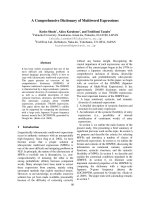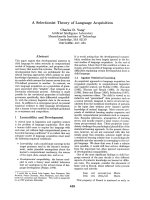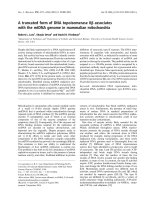Báo cáo khoa học: "A rare case of locally advanced fibrosarcoma of diaphysal humerus managed successfully with limb-sparing procedures after neoadjuvant chemotherapy" pdf
Bạn đang xem bản rút gọn của tài liệu. Xem và tải ngay bản đầy đủ của tài liệu tại đây (680.95 KB, 4 trang )
CAS E REP O R T Open Access
A rare case of locally advanced fibrosarcoma
of diaphysal humerus managed successfully
with limb-sparing procedures after
neoadjuvant chemotherapy
Omar El Mesbahi
1*
, Samia Arifi
1
, Zineb Benbrahim
1
, Abdelhalim El Ibrahimi
2
, Fouad Kettani
3
, Amal Bennani
4
,
Afaf Amarti
4
, My Youssef Alaoui Lamrani
5
, Siham Tizniti
5
, Abdelmajid El Mrini
2
Abstract
Fibrosarcomas (FS) of bon e are a rare malignancy accounting for less than 5% of all primary malignant bone
neoplasms. Diagnosis and treatment approaches of this entity are complex and require a skilled and experienced
multidisciplinary team.
Authors report their experience with a case of FS of humerus showing a pathologic complete response to neo-
adjuvant chemotherapy based on adriamycin, cisplatin and ifosfamid. This approach allowed limb-sparing surgery
with an excellent functional and psychological result.
Background
Fibrosarcomas (FS) of bone represent 5% of all primary
bone sarcomas [1,2]. It occurs most frequently in the
middle age [1], and affects men and women w ith equal
frequency. In addition, it affects most commonly the
longbones.Thetumormaybeeithercentral(68%)or
cortical (31%) [1]. Fibrosarcomas can arises as a prima ry
lesions, or secondary to fibrous dysplasia, to Paget’ s
disease, to bone infarcts, to osteomyelitis, or to post-
irradiation of bone and giant cell tumors (GCT) [3,4].
Histologically tumors are characterized by interlacing
bundles of collagen fibers without any osteoid, or carti-
lage production [1]. Differential diagnosis includes fibro-
blastic osteosarcoma and malignant fibrous histiocytoma
(MFH) [5].
Surgery is the standard treatment for fibrosarcoma of
bone [1]. Amputation was the primary method of ther-
apy, yielding the best curative results [1]. However, by
combining advanced bone imaging techniques with sur-
gical techniques, implant development and neo-adjuvant
therapy, limb-sparing surgery can be safely performed.
Theroleofsystemicchemotherapyisnotestablished.
Few published reports of chemotherapy in FS of bone
have been reported. Chemotherapy regimens used are
similar to those used for osteosarcoma. Given to the
rarity and h eterogeneity of published reports it is not
possible to draw conclusions about the role of neo-
adjuvant chemotherapy in improving patients outcome
and survival.
WepresenthereararecaseoflocallyadvancedFSof
bone experiencing complete pathologic response to
adriamycin-cisplatin-ifosfamid neo-adjuvant chemother-
apy, allowing limb sparing surgery, to illustrate the
antitumor activity of this regimen in this rare tumor.
Case presentation
A 28-year-old woman complained of pain and tumefac-
tion in the upper portion of her right arm. She did not
have fever, or trauma. Physical examination, showed a
raised mass in the proxim al portion of the right arm;
with no clinical signs of neurovascular damage. There
was no l ocal erythema or skin lesions, and no palpable
lymphadenopathy. There were pain and limitation of
abduction, internal and external rotation of the right
limb.
* Correspondence:
1
Department of Medical Oncology, Hassan II University Hospital, Route Sidi
Hrazem, Fez, 30000, Morocco
Full list of author information is available at the end of the article
El Mesbahi et al. World Journal of Surgical Oncology 2010, 8:77
/>WORLD JOURNAL OF
SURGICAL ONCOLOGY
© 2010 El Mesbahi et al; licensee BioMed Central Ltd. This is an Open Access article distributed under the terms of the Cre ative
Commons Attribution License (http://cre ativecommons.org/licenses /by/2.0), which permits unrestricted us e, distribution, and
reproduction in any medium, provided the original work is properly cited.
The remainder of the physical examination was
normal. Radiographs revealed a diaphyseal pathologic
fracture involving the right humerus with a periosteal
reaction. Magnetic resonance imaging (MRI) of the right
arm (Figure 1) showe d an eccentri c mass in the diap hy-
sis of the humerus, accompanied by an overlying perios-
teal reaction. The mass extended to a height of 11 cm,
and into surrounding soft tissues. The shoulder and
elbow appeared normal. There was no skip metastasis.
A biopsy was performed. Microscopic e xamination
showed fascicles of spindle cells with areas of collagen
fibers, with an el evated mitotic index (Figure 2). The
microscopic aspect suggests the diagnosis of high grade
FS of bone.
A technetium-99 m labeled methylene diphospho nate
radionucl ide (Tc 99 m/HMDP) bone scan revealed an
area of increased uptake in the right proximal humerus,
without other foci of abnormal isotope uptake that cor-
responded in location to the abnormalities visualized on
MRI. Computed tomographic (CT) scanning of the
thorax performed revealed no abnorm alities. Laboratory
test results were normal, left ventricular fraction ejection
(FEV) was normal and equal to 69%.
Surgical resection is the st andard treatment of FS of
bone. Early studies support the use of amputation [1].
At the Memorial Sloan-K ettering Cancer Center
(MSKCC) more than 85% patients with histologically
verified primary fibrosarcoma of bone, were treated by
major amputation between 1918 and 1973. Neverth eless
low-grade periosteal FS were treated by local wide exci-
sion rather than ampu tation, with encouraging results
[1]. Also many studies have demonstrated a comparable
rate of disease control and survival with amputation and
Limb-salvage procedures, as long as wide resection mar-
gins are achieved, in the treatment of sarcoma of the
extremities [6,7]. Furthermore conservative surgery
improves the quality of life of patients with best func-
tional results [6,7]. All this data encourage us to believe
that a limb saving surgery should be seriously consid-
ered in the management of FS of bone.
In our case limb salvage surge ry was not possible at
the time of first presentation, and consequently neo-
adjuvant chemotherapy was considered in order to
ovoid amputation, and to achieve a wide surgical
excision.
TheroleofchemotherapyinFSofboneisunknown.
Up to now, no large chemotherapy studies of FS of
bone are published; and o nly few case re ports are
reported. There is no recommendation regarding the
optimal drug regimens, and the protocols used are
Figure 1 Sagittal T1 - weighted MR image at the time of first
presentation, reveals a huge intra- and extraosseous tumor of
the proximal humeral diaphysis.
Figure 2 HESX4 - Spindle cells with interlacing bundles of
collagen fibers without any osteoid, or cartilage production.
El Mesbahi et al. World Journal of Surgical Oncology 2010, 8:77
/>Page 2 of 4
formulated at the discretion of the medical oncologist,
and were most commonly based on Adriamycin and
cisplatin.
API regimen is an active combination in the treatment
of osteosarcoma (French Sarcoma Group FGS) [8] with
37-47% of good pathologic response but there is no data
concerning efficacy of this protocol in FS of bone.
Based on this data, we use the API combination
(adriamycin 60 mg/m
2
and cisplatin 100 mg/m
2
on day
1andifosfamid1.8g/m
2
/d during 5 days with Uromi
thexan (Mesna®) 1800 mg/m
2
/d during 5 days) as neo-
adjuvant chemotherapy. G-CSF (filgastrim) was admini-
strated from day 7 to day 14 of each cycle.
Hematologic and non hematologic tolerance to che-
motherapy was evaluated after each cycle, and we
showed two episodes of neutropenia (grade III and I)
and 1 episode of inter-costal Zona after the second
course of chemotherapy, successfully managed with
Valaciclovir.
Our case showed excellent clinical and radiological par-
tial response (Figure 3) after 3 courses of chemotherapy.
A conservative surgery was performed after 3 cycles;
The patient rece ived limb-sa lvage procedures with wide
local resection of the tumor, reconstruction with hum-
eral centromedullary nailing, and replacement of the
excised segment of bone by cemented spacer.
Interestingly, histological study of the specimen
showed pathologic complete response of the tumor
(Figure 4), suggesting an important antitumor activity of
API combination in FS of bone.
Three post-operative courses of API were pro-
gram med; however, only 2 cycles of chemotherapy were
administrated, and the treatment was discontinued
because of serious adverse event (medullar aplasia that
was successfully managed).
Conclusion
Although it is not possible to make a legitimate conclu-
sion with a single presentation, this rare case of locally
advanced FS of bone highlights the role of adriamycin-
cisplatin-ifosfamid neo-adjuvant chemotherapy to
achieve limb-sparing surgery and to avoid amputation.
The promising results of API regimen in this case sug-
gest the role of chemotherapy in the management of FS
of bone.
More studies are needed to confirm the efficacy and
safety of this regimen in FS of bone and to determine
the optimal treatment plan that will improve the out-
come of these patients.
Figure 3 Sagittal T1 - weighted MR image after 3 cycles of
chemotherapy shows partial decrease in tumor volume.
Figure 4 HESX4 - Complete pathologic response after 3 cycles
of chemotherapy.
El Mesbahi et al. World Journal of Surgical Oncology 2010, 8:77
/>Page 3 of 4
Consent
Written informed consents were obtained from the
patient for publica tion of this case report. A copy of the
written consent is available for review by the journal’s
Editor-in-Chief.
Acknowledgements
We sincerely thank Dr Nabil Ismaili and Mr Hassan Kettani for their linguistic
assistance.
Author details
1
Department of Medical Oncology, Hassan II University Hospital, Route Sidi
Hrazem, Fez, 30000, Morocco.
2
Department of Traumatology, Hassan II
University Hospital, Route Sidi Hrazem, Fez, 30000, Morocco.
3
Laboratory of
Pathology, Avenue Nations Unies, Rabat, 10000, Morocco.
4
Department of
Pathology, Hassan II University Hospital, Route Sidi Hrazem, Fez, 30000,
Morocco.
5
Department of Radiology, Hassan II University Hospital, Route Sidi
Hrazem, Fez, 30000, Morocco.
Authors’ contributions
All authors have made significant contributions by making diagnosis,
treatment and intellectual input in the case and writing the manuscript. All
authors read and approved the final manuscript.
Competing interests
The authors declare that they have no competing interests.
Received: 24 May 2010 Accepted: 6 September 2010
Published: 6 September 2010
References
1. Huvos AG, Higinbotham NL: Primary fibrosarcoma of bone. A
clinicopathologic study of 130 patients. Cancer 1975, 35:837-847.
2. Dorfman HD, Czerniak B: Bone cancers. Cancer 1995, 75:203-210.
3. Hoshi M, Matsumoto S, Manabe J, Tanizawa T, Shigemitsu T, Izawa N,
Takeuchi K, Kawaguchi N: Malignant change secondary to fibrous
dysplasia. Int J Clin Oncol 2006, 11:229-235.
4. McGrory JE, Pritchard DJ, Unni KK, Ilstrup D, Rowland CM: Malignant
lesions arising in chronic osteomyelitis. Clin Orthop Relat Res 1999,
362:181-189.
5. Hattinger CM, Tarkkanen M, Benini S, Pasello M, Stoico G, Bacchini P,
Knuutila S, Scotlandi K, Picci P, Serra M: Genetic analysis of fibrosarcoma
of bone, a rare tumour entity closely related to osteosarcoma and
malignant fibrous histiocytoma of bone. Eur J Cell Biol 2004, 83:483-491.
6. Papagelopoulos PJ, Galanis E, Frassica FJ, Sim FH, Larson DR, Wold LE:
Primary fibrosarcoma of bone. Outcome after primary surgical
treatment. Clin Orthop Relat Res 2000, 373:88-103.
7. Davis AM, Devlin M, Griffin AM, Wunder JS, Bell RS: Functional outcome in
amputation versus limb sparing of patients with lower extremity
sarcoma: a matched case-control study. Arch Phys Med Rehabil 1999,
80:615-618.
8. Piperno-Neumann S, Bui B, Blay J, Roché H, Pichon F, Peny A, Duclos B,
Jimenez M, Perol D, Le Cesne A: A multicentric prospective study of
intensive induction chemotherapy (API-AI) in localized osteosarcoma
patients: Results of a phase II trial coordinated by the French Sarcoma
Group (FSG) and the FNCLCC BECT. J Clin Oncol 2006, 24(18S):9521.
doi:10.1186/1477-7819-8-77
Cite this article as: El Mesbahi et al.: A rare case of locally advanced
fibrosarcoma of diaphysal humerus managed successfully with limb-
sparing procedures after neoadjuvant chemotherapy. World Journal of
Surgical Oncology 2010 8:77.
Submit your next manuscript to BioMed Central
and take full advantage of:
• Convenient online submission
• Thorough peer review
• No space constraints or color figure charges
• Immediate publication on acceptance
• Inclusion in PubMed, CAS, Scopus and Google Scholar
• Research which is freely available for redistribution
Submit your manuscript at
www.biomedcentral.com/submit
El Mesbahi et al. World Journal of Surgical Oncology 2010, 8:77
/>Page 4 of 4









